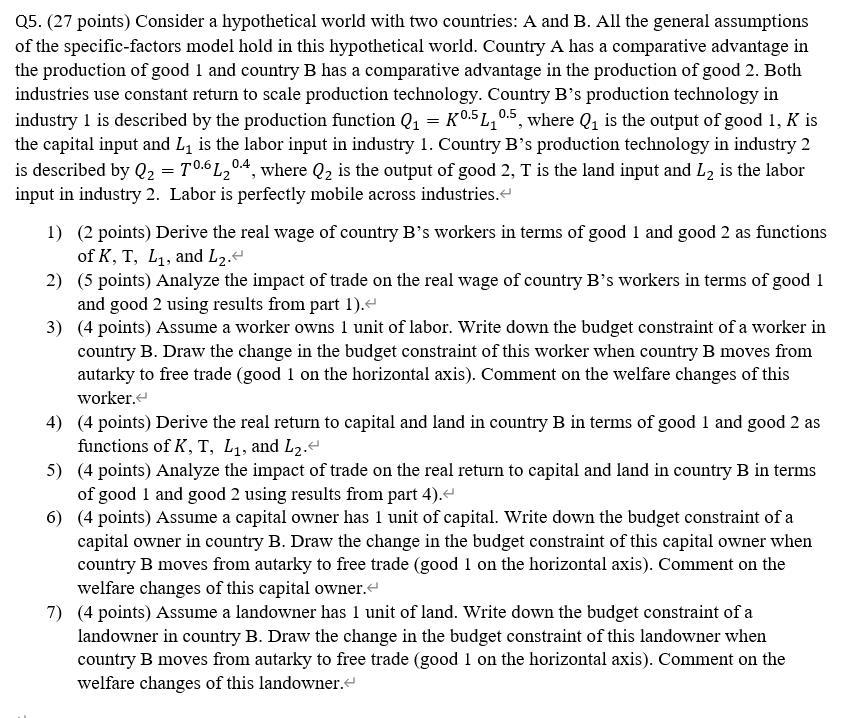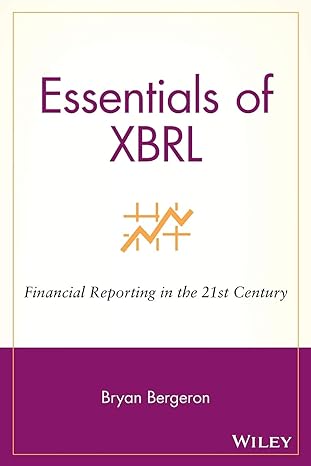
Q5. ( 27 points) Consider a hypothetical world with two countries: A and B. All the general assumptions of the specific-factors model hold in this hypothetical world. Country A has a comparative advantage in the production of good 1 and country B has a comparative advantage in the production of good 2. Both industries use constant return to scale production technology. Country B's production technology in industry 1 is described by the production function Q1=K0.5L10.5, where Q1 is the output of good 1,K is the capital input and L1 is the labor input in industry 1 . Country B's production technology in industry 2 is described by Q2=T0.6L20.4, where Q2 is the output of good 2, T is the land input and L2 is the labor input in industry 2. Labor is perfectly mobile across industries. 1) (2 points) Derive the real wage of country B's workers in terms of good 1 and good 2 as functions of K,T,L1, and L2. 2) (5 points) Analyze the impact of trade on the real wage of country B's workers in terms of good 1 and good 2 using results from part 1 ). 3) (4 points) Assume a worker owns 1 unit of labor. Write down the budget constraint of a worker in country B. Draw the change in the budget constraint of this worker when country B moves from autarky to free trade (good 1 on the horizontal axis). Comment on the welfare changes of this worker. 4) (4 points) Derive the real return to capital and land in country B in terms of good 1 and good 2 as functions of K,T,L1, and L2. 5) (4 points) Analyze the impact of trade on the real return to capital and land in country B in terms of good 1 and good 2 using results from part 4). 6) (4 points) Assume a capital owner has 1 unit of capital. Write down the budget constraint of a capital owner in country B. Draw the change in the budget constraint of this capital owner when country B moves from autarky to free trade (good 1 on the horizontal axis). Comment on the welfare changes of this capital owner. 7) (4 points) Assume a landowner has 1 unit of land. Write down the budget constraint of a landowner in country B. Draw the change in the budget constraint of this landowner when country B moves from autarky to free trade (good 1 on the horizontal axis). Comment on the welfare changes of this landowner. Q5. ( 27 points) Consider a hypothetical world with two countries: A and B. All the general assumptions of the specific-factors model hold in this hypothetical world. Country A has a comparative advantage in the production of good 1 and country B has a comparative advantage in the production of good 2. Both industries use constant return to scale production technology. Country B's production technology in industry 1 is described by the production function Q1=K0.5L10.5, where Q1 is the output of good 1,K is the capital input and L1 is the labor input in industry 1 . Country B's production technology in industry 2 is described by Q2=T0.6L20.4, where Q2 is the output of good 2, T is the land input and L2 is the labor input in industry 2. Labor is perfectly mobile across industries. 1) (2 points) Derive the real wage of country B's workers in terms of good 1 and good 2 as functions of K,T,L1, and L2. 2) (5 points) Analyze the impact of trade on the real wage of country B's workers in terms of good 1 and good 2 using results from part 1 ). 3) (4 points) Assume a worker owns 1 unit of labor. Write down the budget constraint of a worker in country B. Draw the change in the budget constraint of this worker when country B moves from autarky to free trade (good 1 on the horizontal axis). Comment on the welfare changes of this worker. 4) (4 points) Derive the real return to capital and land in country B in terms of good 1 and good 2 as functions of K,T,L1, and L2. 5) (4 points) Analyze the impact of trade on the real return to capital and land in country B in terms of good 1 and good 2 using results from part 4). 6) (4 points) Assume a capital owner has 1 unit of capital. Write down the budget constraint of a capital owner in country B. Draw the change in the budget constraint of this capital owner when country B moves from autarky to free trade (good 1 on the horizontal axis). Comment on the welfare changes of this capital owner. 7) (4 points) Assume a landowner has 1 unit of land. Write down the budget constraint of a landowner in country B. Draw the change in the budget constraint of this landowner when country B moves from autarky to free trade (good 1 on the horizontal axis). Comment on the welfare changes of this landowner







